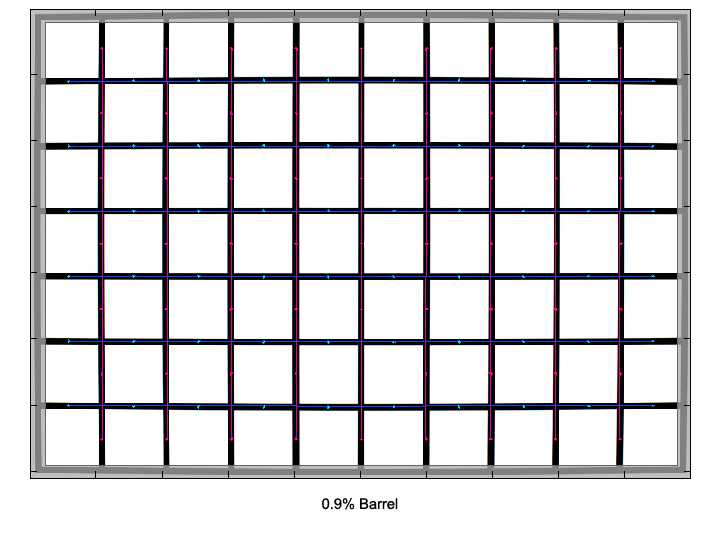|
Page 2 of 2

Distortion
The lens shows a small amount of barrel distortion on DX cameras.

The chart above has a real-world size of about 120x80cm.
Vignetting
Being a FX lens, the Nikkor profits from the sweet spot advantage on DX cameras. So, even though it's a very fast lens, it shows only moderate vignetting wide open, which is reduced to an irrelevant level at f/2 already.

MTF (resolution)
The lens delivers very good resolution in the image center wide open. Stopped down do f/2, the center resolution is already excellent and stays on a very high level down to f/8. From f/11 onwards, diffraction significantly reduces the resolution figures.
Borders and corners are less impressive with just fair resolution wide open. Stopping down lifts the resolution to higher levels in both areas. At f/4 the lens delivers very good resolution across the whole DX image frame.
The lens showed some focus shift when stopping down (residual spherical aberration).
Please note that the MTF results are not directly comparable across the different systems!
Below is a simplified summary of the formal findings. The chart shows line widths per picture height (LW/PH) which can be taken as a measure for sharpness.
If you want to know more about the MTF50 figures you may check out the corresponding Imatest Explanations

Chromatic Aberrations (CAs)
Chromatic aberrations (color shadows at harsh contrast transitions) are quite pronounced, reaching almost 2.5 pixels at the image border wide open. Stopping down reduces the amount a little, but even at f/11 there are almost 2 pixels of CA left.
However, CAs can easily be corrected in software or by the camera itself (most modern Nikon DSLRs remove CAs themselves if you shoot JPGs).

Bokeh
One of the primary usage scenarios for a large aperture lens is to seperate the main subject from the background. In such an image the quality of the bokeh (out-of-focus blur) is of major significance.
Bad news first - the bokeh wide open is a bit nervous. This is not only true for the transition zone, were most lenses struggle, but also for subjects at some distance from the focal plane. However, this is actually a quite typical behaviour of wide angle lenses with an aspherical element. The good news (not visible in the image below): the bokeh improves quite a bit by stopping down and becomes very smooth at f/2.8.
Thanks to 9 rounded aperture blades, background highlights retain their circular shape throughout the whole aperture range, except towards the image corners. Due to vignetting they are cut off at one side at wide open and to some degree also at f/2. There is a small amount of outlining and some traces of bokeh fringing (which is typical for this lens class, see next section).

Bokeh Fringing
Bokeh fringing is a common issue with relatively fast glass. It's visible as halos of different colors in out-of-focus areas - magenta (red + blue) in front of the focus point
and green beyond.
Typical for most fast primes, especially ultra fast ones, the AF-S 35 shows some amount of bokeh fringing at large aperture settings, which can of course be reduced by stopping down.
In addition, these shots also show the focus shift when stopping down, which was mentioned in the MTF section.
Sample Images
You can find some sample images taken with the Nikon D3x in our Nikon FX review of the lens.
VerdictThe Nikon AF-S 35mm f/1.4 G is able to deliver impressive results on our DX test camera, however it is not without flaws. The image center is very sharp right from the largest aperture, but the borders and corners are quite soft wide open. The lens needs to be stopped down a bit to delivers good to very good resolution across the frame.
Distortion is no issue on DX cameras. Vignetting is a bit pronounced wide open, but that's typical behaviour for such a fast lens. Stopping down slightly resolves this issue. Typical for a fast prime, some bokeh fringing is present at larger apertures.
The amount of CAs at the image border is quite high. In addition, the bokeh is somewhat nervous wide open. However, this issue can be solved by stopping down to f/2.8 or beyond (if the subject or the available light allows).
As you'd expect from a professional grade lens, the build quality is on a very high level including sealing against dust and moisture. AF is a bit slower than with other high-end lenses, but still fast enough for most applications.
To sum it up: despite some issues the lens works quite well as a normal lens on the D7000. A very expensive normal lens, though.
|